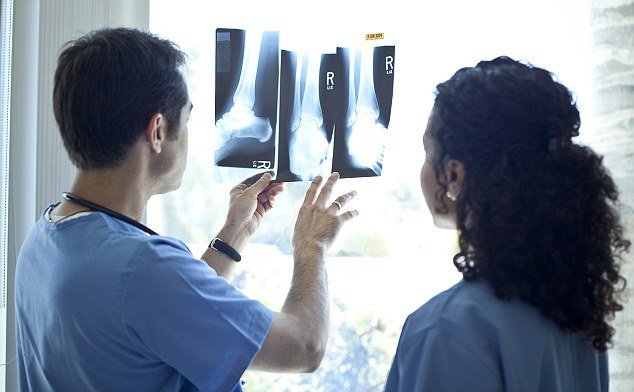Contents:
- Medical Video: Obesity Health Risks
- Various health conditions that must be immediately taken into the emergency room
- 1. Severe headache
- 2. Unbearable abdominal pain
- 3. Chest pain
- 4. Serious infections
- 5. Bloody urine or bloody bowel movements
- 6. Shortness of breath
- 7. Wounds, lumps, and bleeding
- 8. Vomiting
- 9. High fever
- 10. Numbness in the limbs
Medical Video: Obesity Health Risks
You might panic when a family member has a very high fever, a heart attack, or suddenly has difficulty speaking. You really know that this requires medical care, but is it necessary to enter the emergency room?
A study showed that as much as 20 percent of visits to an emergency room (ED) were apparently not needed. This certainly causes unnecessary costs and is a waste of time. So, how do you know the condition of someone who must be immediately taken to the emergency room? Consider the following review.
Various health conditions that must be immediately taken into the emergency room
1. Severe headache
Headaches feel like a trivial disease that can be cured only by taking medication. Generally, headaches experienced by most people are caused by hypertension and migraines.
However, there are a number of headache conditions that must be immediately referred to the hospital. Immediately bring your family member into the emergency room if you have a severe, intense headache that feels like being hit continuously, and suddenly. According to Dr. Ryan Stanton, an emergency health services expert and spokesman for the American College of Emergency Physicians, this condition is used to measure the risk of potentially deadly headaches, such as subarachnoid bleeding.
Beware when the headache you feel is also accompanied by fever, neck pain, stiffness, and a rash. Because, this can be a symptom of meningitis.
2. Unbearable abdominal pain
Many people enter the emergency room because they feel a stomach ache. The pain caused can be caused by several factors, ranging from gas deposits in the stomach, stiff stomach muscles, or more serious conditions such as appendicitis and urinary tract infections.
If you experience symptoms of abdominal pain in the form of a puncture in the lower right or right side of the abdomen, immediately go to the emergency room. This can be a sign of a problem with the appendix or gallbladder that requires further treatment.
Other symptoms of abdominal pain that can bring you into the emergency room are when stomach pain is accompanied by difficulty inserting food or fluids into the body, bleeding (defecating), and unbearable pain. So, pay attention to the symptoms of abdominal pain that you feel so there is no misstep handling.
3. Chest pain
Sudden chest pain, commonly known as a heart attack, is also a major cause of someone entering an emergency room. People who experience these symptoms usually get treatment ahead of other symptoms to reduce the risk of severity.
Immediately go to the ED if you experience chest pain accompanied by shortness of breath, sweating, and pain that travels to the neck, jaw, or arms. Because the disease is related to the heart organ so that it cannot be treated by an outpatient medical examination.
4. Serious infections
Most infections are caused by viruses. This is why infection cannot be treated with antibiotics or over-the-counter drugs. To find out the condition of the infection that is needed or not taken to the emergency room can be seen from the severity of the symptoms.
Severe infections include sepsis, pneumonia, meningitis, and infections in people with low immune systems. So, immediately bring family members to the emergency room if you have an infection accompanied by low blood pressure, weakness, and cannot drink any fluids.
5. Bloody urine or bloody bowel movements
Urination or normal bowel movements are not found in red spots or blood in the urine or feces. Conversely, this will be a problem if you experience bloody urine or bloody bowel movements.
Blood in the urine is usually caused by several types of infections, such as the urinary tract or kidney stones. While in the stool, blood spots can be caused by hemorrhoids, infections, inflammation, boils, and cancer.
If you experience any of these conditions, immediately go to the ED to get further treatment. This also applies if you have bloody urine or bloody defecation accompanied by symptoms such as fever, rash, and severe pain.
6. Shortness of breath
People who experience shortness of breath are often immediately taken to the emergency room to be given medical treatment. Because, any disease accompanied by shortness of breath can no longer be tolerated just by taking medication.
The most common causes of shortness of breath include asthma, chronic obstructive pulmonary disease (COPD), blood clots, strokes, or heart attacks.
7. Wounds, lumps, and bleeding
Knife wounds or bruises due to falling inside the house are usually dealt with with ice compresses or first aid boxes in accidents (first aid kit). But be careful, there are several conditions for wounds or lumps that require you to enter the emergency room immediately.
How do you tell the difference? It's easy, if you can see your muscles, tendons, or even your bones from open wounds, then you need immediate medical treatment in the emergency room. Especially if you experience bleeding for 10 to 20 minutes without stopping which makes it difficult for you to move injured limbs. This is very important to avoid infectious complications in the form of more severe nerve or tendon damage.
8. Vomiting
Vomiting is one of the common symptoms that arise from digestive problems or food poisoning. This can usually be treated with natural ingredients at home or see a general practitioner.
However, vomiting can also indicate some serious illness that requires you to go to the emergency room immediately. Signs and symptoms of vomiting that are dangerous are vomiting blood with severe abdominal pain and dark green vomiting that indicates obstruction or blockage in the intestine.
If you cannot resist vomiting, immediately fill your fluid needs so you are not dehydrated. This is also important for children who experience vomiting, because children experience dehydration more quickly than adults so they need to be treated more quickly.
9. High fever
Basically, fever is a good sign that the body is responding to an infection in the body. Therefore, what needs to be considered is not the fever itself, but rather the type of infection that causes the body to fever.
Fever can usually be treated with ibuprofen or paracetamol which functions to reduce fever. Meanwhile, fever signs and symptoms to watch out for are fever accompanied by a weak body, headache, or neck pain - both in children and adults.
If you experience one of them, immediately go to the hospital and enter the emergency room to get treatment for the medical team.
10. Numbness in the limbs
Same as symptoms of difficulty breathing, numbness or numbness in the limbs is one reason someone must enter the emergency room and get immediate treatment. If you feel a sudden feeling of numbness in the body or at certain times in the legs, hands, facial muscles, to difficulty speaking, immediately go to the ED to find out the cause.
Numbness in the limbs is generally caused by physical trauma or stroke. These two things are serious conditions that require further medical treatment.





















